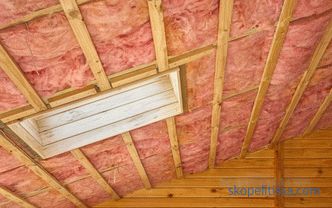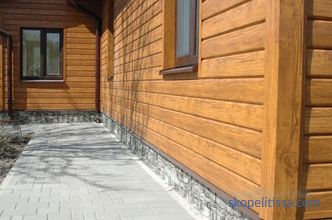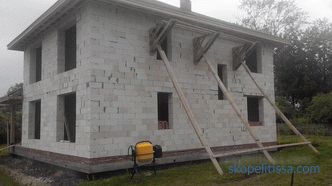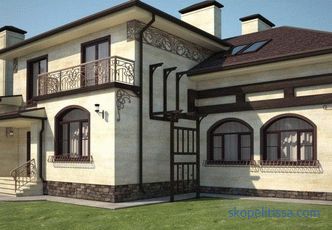Today, the insulation of the roof of the house is a mandatory process. Small financial investments and simple construction operations will make it possible to save a lot on heating. Indeed, as practice shows, heat loss through the roof is up to 20%. Therefore, in this article we will describe which heaters are used for this, which technologies are used.

Types of heat insulation material used
Roof insulation includes It is a warming of the slopes of the structure, or rather the space between the rafter legs. Here we are not talking about the insulation of the ceiling of the attic, where you can use bulk materials. Therefore, claydite, sawdust, perlite, vermiculite, etc. in this case do not apply.
The main types of insulation used in the insulation process are mineral wool, polystyrene foam boards and polyurethane foam. The first two are mats and plates, the second is a colloidal mass in the form of foam, which polymerizes in air into a durable coating with the best thermal performance. But it should be noted that polyurethane foam - the material is not cheap.
Technology of house roof insulation
Roof insulation is carried out using two practically identical technologies.
-
From above , when the roofing material is not yet mounted.
-
From the inside of the attic when the roof covering is already installed and fixed.

First choice
It starts everything equal from the inside, that is, from the truss system.
-
First, along the rafters (across) , the vapor barrier membrane is laid. Laying is done with overlapping strips with an offset of 10-15 cm. Steam insulation strips are fastened to the rafters with metal clips using a stapler. The joints between them are closed with self-adhesive tape or building tape.
-
The filing of the truss system is made by plate, lath or sheet materials: plywood, chipboard, OSB, edged boards, wall paneling, drywall and others.
-
Now the whole process is transferred from above the rafters . Between them, the insulating material is laid so that it is pressed tightly against the rafter legs with its edges. We must not allow minimal gaps, which in the process of operation will become cold bridges, that is, they will pass cold air through themselves.
-
Above the rafters the waterproofing membrane is laid in the same way as the vapor barrier is underneath. It is necessary to install a waterproofing film from the eaves of the roof in the direction of the ridge across the rafter legs. In this case, the edges of the upper bands should cover the edges of the lower bands. Strongly stretching the film can not be, a small slack will provide an opportunity to compensate for the change in its size at negative and positive temperatures.
-
It remains only to mount the crate and the roofing material.
On our site you can find contacts of construction companies that offer the service insulation houses turnkey. Directly to communicate with representatives, you can visit the exhibition of houses "Low-rise Country".
Second variant
Warming the roof from the inside - on the one hand, the process is simple, on the other hand, it requires knowledge of some nuances. Let's start with thermal insulation using polyurethane foam, as with the simplest, but also the most expensive.
This foam insulation sticks to any building material regardless of its adhesive qualities. Therefore, polyurethane foam is applied without prior preparation of the rafters and roofing material. It is fed under pressure through a hose and a special nozzle.
It should be noted that polyurethane foam is a material that is afraid of sunlight. Under their negative effects, it cracks, turns brown, cracks and breaks. Therefore, if there are dormers in the attic, through which the sun will penetrate into the attic room, the insulation will have to be closed. If the sun's rays under the roof do not penetrate, then the heat-insulating layer can not be closed.
Thermal insulation with mineral wool
Let us immediately indicate that mineral wool is a hygroscopic material, that is, it is well absorbing moisture. Under its action, he quickly loses its thermal properties. Therefore, it is important to have a good waterproofing of the roof.Inside it is done like this:
-
a vapor barrier film is installed so that it fits the roof rails and covers the space between them (you can see it well in the photo below);
-
between the rafters laid mineral mats wool (in the photo above it is also clearly visible, how to do it), the main requirement is that the insulation does not stick out to the rafters, but pressed tightly to them;
-
from above the vapor barrier film , which Toraya is laid in strips, like the upper waterproofing, only it is stretched along the rafter legs;
-
it remains only to stuff sheet or slab material onto the truss system from inside .
It can be interesting! In the article on the following link read about how to better warm the ceiling in the house.
Warming up with polystyrene plates
Warming of the roof from the inside with polystyrene foam plates is almost the same as the previous version. It is just necessary to designate that polystyrene foam is almost non-hygroscopic material. Especially in this regard, the plates under the brand "Penoplex" performed well. According to all characteristics, it is better than mineral wool with one drawback - expanded polystyrene plates support combustion. But this does not prevent them from being used for insulating roof structures.
We add that the advantage of using polystyrene foam plates is the ability to discard the protective layers. That is, there is no need to use waterproofing films. Therefore, the plates are simply placed between the truss legs. The main requirement is the minimum number of gaps and slots with minimum dimensions between the insulation plates and between them and the rafters. Therefore, the insulation is trimmed as accurately as possible in accordance with the installation step rafters.
If the gaps cannot be avoided, they are filled with a special adhesive composition that looks like a mounting foam, only in volume it does not expand. The material will not only fill the gap, but also attach insulation to the rafter legs.
Today, manufacturers offer Penoplex with foil-coated coating, which increases the thermal insulation performance of slabs the account of the reflection of thermal radiation emanating from inside the rooms of the house. That is, the preservation of thermal energy.
Warming with penofol
This insulation is a layer of foamed polyethylene coated with either one or both sides of the foil. Flexible, thin and cheap, but with good thermal insulation properties, penofol has recently become more often used in thermal insulation processes. In the insulation of the roof in a wooden house from the inside (and not only in wooden), it is used as a roll coating.
It is simply placed on the inside of the attic on the rafter legs and attached to them with metal clips or small carnations with a wide hat. The main thing is to lay the joint into the joint with the gluing of the joint itself with a self-adhesive foil-coated film. Then, along the rafters, slats are made their way (this is lathing) along which sheet or slab material will be installed later.
It can be interesting! In the article on the following link read about what insulation is better for a frame house.
What kind of insulation is better
It all depends on characteristics such as thermal conductivity. The smaller it is, the better the thermal properties of the material, the smaller layer it can be laid.
| Insulation type | Heat conductivity, W / m K |
| Mineral wool | 0.032-0.05 |
| Polystyrene plates | 0.03-0.035 |
| Polyurethane | 0.019-0.02 |
| Penofol | 0.049 |
Please note that the thermal conductivity of penofol is not the best in the list. But the thickness of this material is 4 mm. The thickness of the mineral wool - 50 mm, polystyrene foam plates - 47 mm. In this regard, polyurethane foam still wins. It also has better thermal performance than other heaters, and the applied layer does not exceed 50 cm. In addition, the foam insulation is applied without joining. The layer is solid, durable.
Step by step roof insulation from the inside is displayed in the video:
It might be interesting! In the article the following link read about insulation penoplex.
Summary on the topic
Warming the roof in a wooden house (and not only) is a serious process that requires a special approach to construction work. The main task is to choose a heat-insulating material, and strictly follow the technology of its installation.
Rate this article, we tried for you



